Proposal for Independent Study
with Prof. Casey Reas
project by Michael Chang UCLA D|MA 2005
Winter 2005 Syllabus
My focus for this independent study will
be to improve my expression of art, design, and research through
a code. By the end of this project I want to be better at expressing
complex concepts effectively through code and interactive/generative
media.
The analogy that I'm expressing is "cellular
morphogenesis", the act of thousands of building blocks forming
complex, higher level forms that have function and behavior. I
will demonstrate this by writing a simulation program that achieves
the following goals:
1. clearly expresses the idea of this "cellular
morphogenesis" to human beings
2. have a strong sense of asthetics, being beautiful to look
at
3. backed by research to properly demonstrate what it's actually
doing
Background on "Cellular Morphogenesis"
The idea came to me reading while The
Emergence of Everything by Harold J. Morowitz on a chapter
about the emergence of multicellularity and its implications.
The interest for me here is the emergence of this phenomenon,
that individual and autonomous cells could group together to cooperate
and even specialize, eventually forming functional living animals.
Specifically, the move up from a lower level of complexity (cell
structure, organelles, cell walls, etc) to a higher level of complexity
(cells specializing into skin cells, nerve cells, bone, tissue,
etc) is what excites me to no end. I want to be able to not only
express this idea in a programmed and algorithmic environment
on the computer, but also have people understand and learn about
this concept, and at the same creating a beautiful piece of generative
art.
The "End Product"
By the end of this independent study I want
to have a fully functional simulation program written in either
Processing or C++/OpenGL, installed in a gallery running on projection
with prints and info-graphics introducing my concept to the viewer.
---Timeline--------------------------------------------------------------------------------
Week 2 - set proposal, research, write-up,
sketches
Week 3 - research + begin design + additional
sketches
Week 4 - design and programming
Week 5 - continue design + programming.
Week 6 - design + review
Week 7 - design + second review
Week 8 - finalizing, bug cleanup
Week 9 - presentation
-------------------------------------------Week
3-------------------------------------------
Week 3 begins with research and design phase.
Emergence
from Wikipedia (my notes/highlights
in color)
Emergence is the process of deriving some
new and coherent structures, patterns and properties in
a complex system. Emergent phenomena occur due to the pattern
of interactions between the elements of a system over time. Emergent
phenomena are often unexpected, nontrivial results of relatively
simple interactions of relatively simple components. What distinguishes
a complex system from a merely complicated one is that in a complex
system, some behaviours and patterns emerge as a result of the
patterns of relationship between the elements.
An emergent behaviour or emergent
property is shown when a number
of simple entities (agents) operate in an environment, forming
more complex behaviours as a collective.
A system made of several things can host properties which the
things themselves do not have. For instance, consider two points
on a plane. These points will have a distance between them. This
distance is not itself a property, but exists in the relation
between the points. Emergent properties can arise not only between
things in the system, but between other emergent properties. The
number and subtlety of these properties can be very much greater
than the number of things.
Emergent properties arise when a
complex system reaches a combined threshold of diversity, organisation,
and connectivity. The property itself is often
unpredictable and unprecedented,
and represents a new level of the system's evolution. The complex
behaviour or properties are not
a property of any single such entity, nor can they easily be predicted
or deduced from behaviour in the lower-level entities.
The shape and behaviour of a flock of birds or school of fish
are readily understandable examples, and it is typical that the
mechanisms governing the flock or school are harder to grasp than
the behaviour of individual birds or fish.
This helps to explain why, for instance, the
number of ways of packing boxes into a truck increases exponentially
with the number of boxes and why the fallacy of division is a
fallacy. According to an emergent perspective, intelligence emerges
from the connections between neurons, and from this perspective
it is not necessary to propose a "soul" to account for
the fact that brains can be intelligent, even though the individual
neurons of which they are made are not.
Emergent behavior is also important in games
and game design. For example, the game of poker, especially in
no limit forms without a rigid betting structure, is largely driven
by emergent behavior. For example, no rule requires that any player
should fold, but usually many players do. Because the game is
driven by emergent behavior, play at one poker table might be
radically different from that at another, while the rules of the
game are exactly the same. Variations of games that develop are
examples of emergent metaplay, the predominant catalyst of the
evolution of new games.
Emergent structures are patterns
not created by a single event or rule.
There is nothing that commands
the system to form a pattern, but
instead the interactions of each part to its immediate surroundings
causes a complex process which leads to order. One might conclude
that emergent structures are more
than the sum of their parts because
the emergent order will not arise if the various parts are simply
coexisting; the interaction of
these parts is central.
A biological example is an ant colony. The queen
does not give direct orders and does not tell the ants what to
do. Instead, each ant reacts to stimuli in the form of chemical
scent from larvae, other ants, intruders, food and build up of
waste, and leaves behind a chemical trail, which, in turn, provides
a stimulus to other ants. Here each ant is an autonomous unit
that reacts depending only on its local environment and the genetically
encoded rules for its variety of ant. Despite the lack of centralized
decision making, ant colonies exhibit complex behavior and have
even been able to demonstrate the ability to solve geometric problems.
For example, the ant colonies routinely find the maximum distance
from all colony entrances to dispose of dead bodies.
Emergent structures also include cities
and many natural phenomena including the shape of galaxies. Because
they form order despite the lack
of command, emergent structures may
appear to defy entropic principles.
Emergent processes or behaviours can be
seen in many places, from any multicellular
biological organism to traffic patterns or organizational phenomena
to computer simulations and cellular automata.
The stock market is an example of emergence on a grand scale.
As a whole it precisely regulates the relative prices of companies
across the world, yet it has no leader; there is no one entity
which controls the workings of the entire market. Each agent,
or investor, has knowledge of only a limited number of companies
within their portfolio, and must follow the regulatory rules of
the market. Through the interactions of individual investors the
complexity of the stock market as a whole emerges.
Emergent structures appear at many different
levels of organisation. As mentioned earlier, the spatial structure
of galaxies is an emergent property of the distribution of energy
and matter in the universe. Similarly weather phenomena such as
hurricanes are emergent properties as is life itself. Consciousness
is an emergent property of a network of living cells. Emergent
self-organisation appears frequently in cities where no planning
or zoning entity predetermined the layout of the city.
Summary from this Wikipedia article
Important things to show about emergence:
agents operating in an environment and forming complex behavior
or structures, of which could accomplish what the agents themselves
could not have before. It is important to show how this system
could create new and unexpected results, not predicted by the
lower-order forms (the agents themselves). Another important thing
is to have these agents "form order despite the lack of command".
Some questions and concerns:
I don't want the constituent parts (agents, individual cells)
to become simply "movable, adjustable parts" in a creature.
But then again, showing cells on their own would not make much
sense, since the focus is on multicellularity and the forms that
evolve from the concept. If I'm doing evolving virtual creatures,
evolving virtual airplanes, evolving virtual whatever, these cells
act basically like "building blocks". How abstract should
the cells be? Should they look and behave like cells? Should they
be abstract "parts" to a creature? This question may
actually be a purely cosmetic one, however.
Should the software focus on the cells forming
to become a higher level creature?
Or should it focus on the forms that the cells make, assuming
they already have?
I think from an aesthetic point of view (this is a media art
piece, after all) showing forms, patterns, and structures emerge
from multiple cells that look like they are independent
(or, could be if seperated from the mass) is more interesting.
The focus should be on the forms created with these cells, as
opposed to the actual process in which cells come together and
form higher complexity.
Morphogenesis
and Developmental
Biology from Wikipedia
Some important excerpts from Developmental Biology:
Developmental biology studies the genetic control
of cell growth, differentiation and "morphogenesis,"
which is the process that gives rise to tissues, organs and anatomy.
Embryology is sometimes reserved to refer more specifically to
the study of organisms between the one-cell stage (generally,
the zygote) and the beginning of free living.
I will not be focusing
on embryonic development though, and possibly assume my creatures
give offspring in rather simple ways, however the growth of cells
within a creature might be very important...
Quotes from The Emergence of Everything on
Multicellularity
"Among single celled organisms, it often
happens that cells divide and do not split apart, but show a stickiness
that leads to colonies. When this is followed by variable differentiation
of the cells of a cluster into different forms, we refer to the
phenomenon as morphogenesis"
I am going to focus on the animal taxa as
opposed to flora or mushrooms/fungus. Animals have animation,
and forms that can perform animation are of interest to me.
Some notes and concerns
How many cells should my creatures be composed
of? This falls under a computer science question because in the
end I will have to optimize it in order to perform in real time.
Or should it be in real time at all? Perhaps it should be rendered
out, like Karl Sims Evolving Virtual Creatures since my creation
is non-interactive.
Early estimates:
| |
Real Time |
Rendered |
|
Multiple Creatures Environment
|
25-80 cells |
150-250 cells |
| Single Creature Environment |
150-400 cells |
350-1000 cells |
This also depends on how complex the interactions are between
each cell, how it's organized and written, and what the visual
display is. These estimates are far too early at the moment.
Priority Design Questions (these need to be
answered!)
1. What determines success of a creature? Meaning,
what quality are the creatures being selected for? Survival? Competition
for speed? Competition to accomplish a task? (this assumes creatures
automatically evolve motility).
Any competition involving animation is interesting.
Swimming will be first, then to various tasks like attacking other
creatures!
2. What are the ways in which breeding and offspring
of successful designs processed? Random mutations? Mix gene pools?
Mixing gene pools of successors seems to be
ideal, though how it's done remains to be seen.
3. What do individual cells do, on their own?
What's the level of interactivity between cells, and should this
be represented? If so, how?
Little. The cells interact with each other
through connections, but as an individual they will only react
to physics (forces, friction, kinetic energy, etc).
4. What will the environment be? Will there be
immediate competition against other creatures in a live environment?
Will there be physical terrain to traverse? How important is this
to the study of emergence and evolution?
No initial environment, especially selecting
for creatures with the fastest motion through a fluid.
5. How abstract or literal should cells and creatures
be?
Abstract at the cell level, but closer to
literal at a creature level, hopefully.
Visual Design
Below are some images I found for what I want
my piece to look like. Notes are underneath each.
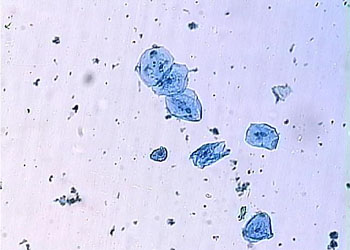
This color, depth, and the sense of a microscopic
world might be an
interesting asthetic to take into this software.
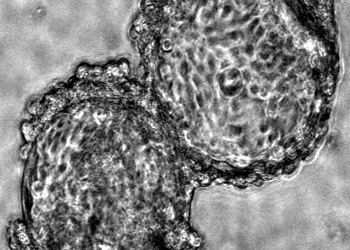
I'm not sure how literally to take the cells
analogy just yet, especially
with visual appearance. Although I do like the clear dilineation
between background and foreground forms while still having a clear
sense of texture and ambiguous form.
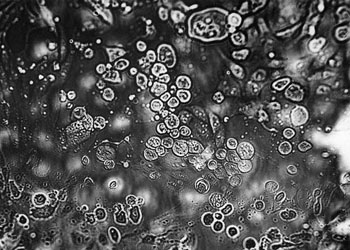
The more I look at these the more I think
"this is what's expected"
and the more I feel like staying away from a purely microscope
visual asthetic.
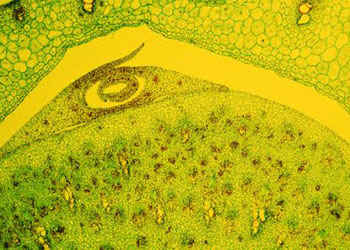 In thinking about colors, how far do I want
colors to be
In thinking about colors, how far do I want
colors to be
representational versus purely asthetics? Do I want a HUD?
Do I want lame programmer colors? Do I want a visual display
that reads more clearly for showing cell division, cell
specialization, as opposed to just making it look beautiful?
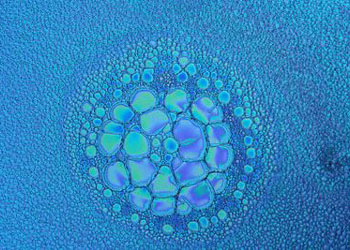
How literal should the visual appearance
of creatures
and cells be? Should they be abstract computer CG cells?

Moving away from microscopic asthetic on
the opposite extreme,
creatures and their constituents can be completely abstract.
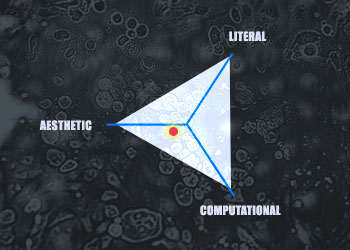
Here is a visual map of the search
space of asthetics I can take with this project.
Aesthetic,
being what it is, beautiful and good to look at. At its purest
level, one cannot tell what this project is about. It would be
abstract or even painterly.
Literal is
to take this project in a very literal-construal way, depicting
cells as they are under a real microscope, flagella et al. Since
this is not a scientific research project, a full swing in this
direction is probably not a good idea.
Computational
is more abstract, and at its purest level everything would just
be numbers or programmer colors, lines, and symbols representing
what's going on.
As this project progresses I'll
discover more about where I want to be on this map. Right now
I'm aiming at the red dot, something more artistic and abstract
than literal, yet borrowing from the visual language of cells
under microscopes, but at the same time provide visual clues with
a toggle-able HUD.
Probably during development, graphics
will be kept simple and as computational as possible. On the side,
a visual identity will be developed, especially towards the end.
-------------------------------------------Week
4-------------------------------------------
So this week's meeting got nyxed
because I didn't have much to show for wednesday. Nonetheless,
I continued working after I got back at full pace. Here are some
progress.
Springs
Before getting started I realized that springs would be an important
technical element to make things look and feel realistic. Chaim
Gingold from MAXIS once sent me example code showing how he implemented
his springs. His code worked with scalar values, and I needed
mine to work with my own vector classes, so I wrote my own spring/force
function based on his code.
My code looks like this:
vector getSpringForce(position from,position to,float desiredLength,float constant)
{
vector force=new vector(from,to);
if(dist(from,to)!=0)
{
vector deltaLength=new vector(force);
position targetPos=new position(to.displace(getHeading(to,from),desiredLength));
deltaLength=new vector(from,targetPos);
force=new vector(deltaLength);
force.m*=constant;
}
return force;
}
The function returns a force vector
to move an object a certain distance away from another object.

View
Applet. The mouse moves the orange circle, while the blue
circle
acts like the recieving end of a spring. The red dot indicates
the desired
distance away from the orange circle.
Lattice
To test this new springs code, I wrote a quick "lattice"
class, basically a collection of points with applied springs against
each other. The result was surprising and fun to look at, and
the motion was unexpected...

View
Applet.
Two nodes will follow the mouse.
Even though they were coded to "stick" to the mouse,
they behaved as if they were magnets in a larger collection of
other magnets drawing them away from the mouse. The motion of
these nodes trying to organize themselves into a relaxed state
was fun to watch, especially when the two penetrate the patten
formed by the others. Reducing the number of node immediately
makes resolving the tension a lot faster, however it just becomes
a polyhedron.
Structure
The next step is to create some form of structured network between
these nodes, and actually make these nodes "cells".
I'm not quite sure yet how structures should be formed. I'm quite
certain that there should be at least three different types of
connections between cells, but I'll write about this later.
This sketch is to illustrate a formation
of networked cells to form structure, rather than cohesion (which
will be dealt with later). From my reading, one of the most important
things about demonstrating emergence is the agents' capacity to
interact with each other, forming connections that would allow
emergent properties to form. Because everything's created procedurally,
I could collect the data required to generate these forms (multiple
data structures right now) and regenerate them, modify them, etc.
The data structure used to make
these right now is inefficient, but it does the job. Every "cell"
has a list of connections, numbered 1 through N (the amount of
cells). These connections will be the only "significant"
connection, beyond making cells cohesive and collide against all
other cells. I've taken the liberty to make these designs bi-lateral...
more on this later.

View
Applet. Click the applet to make a new formation.
Some Notes
for Today
I think there should be multiple types of connections that cells
can make with each other, while each cell would remain identical
by type. These connection types are ofcourse artificial, but they
intend to represent deeper levels of chemistry and physics at
atomic levels that I don't care to simulate. We're going to assume
these three connections for now (based on organic analogies):
Bone - cells connected to
other cells via this connection will have strong tension threshold
for their springs. I'm not sure if I'm going to allow these cells
to be too far apart. I want to allow for a chain link of bone
cell connections that form large-scale physical constructs.
Nerve - cells connected to
other cells via this connection can transmit signals, much like
a tiny neural network. I'm hoping that looped neural networks
might form for some interesting interactive behavior. I'm not
sure how they should work yet, though.
Muscle - cells connected
to other cells via this connection can take recieved signals and
contract their springs, releasing after some delay. Like a bone
connection, I'm not certain whether I should allow this at longer
distances.
Finally, should a cell have multiple
types of connections to other cells? Can a muscle cell also be
a nerve cell?
-------------------------------------------Week
5-------------------------------------------
Lattice 2
(view
applet)
I allowed adding nodes by clicking on the app to investigate
why the nodes destabilize and begin to undulate into itself. I'm
guessing it's a bug with my springs, or how I implemented them.
Gemone
After rereading Karl Sim's paper
on Evolving Virtual Creatures, I realized that the best way
for me to procedurally create colonies of cells would still have
to be a directed graph. I'm currently modeling his approach by
generating genomes (a blueprint of instructions) and phenomes
(recursively reading bits of this blueprint). This sketch only
shows the direction of the next cell growth, and do not
reflect the end-shape of the creature. Currently there's a bug
preventing the root node from ever generating additional "giant
branches". It's possible that my implementation might be
flawed, too.
At any rate, this approach generates
highly complex forms with relatively little data, and contains
the possibility of recycling useful data, such as instructions
on how to build an arm. The sketch demonstrates that patterns
emerge and re-emerge by recycling data. This is a big improvement
over the "structure" sketch.
The next step is to apply springs
to these.